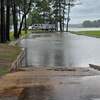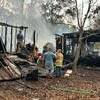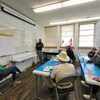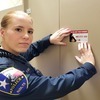County schools continue putting safety first
Editor’s Note: This is the second in a two-part series looking at how the local school districts are keeping students and staff safe on campus. This article features Rusk, Bullard and Wells ISDs. Check out the Wednesday, Oct. 2 edition of the Cherokeean Herald online to read about Alto, Jacksonville and New Summerfield ISDs.
There have been at least 479 incidents of gunfire on school grounds since 2013, nationwide, resulting in 182 deaths, includ-ing 33 suicide deaths (where no one else was harmed) and 367 injuries, including six self-harm injuries (where no one else was harmed), according to the website, Everytown for Gun Safety.
A new state law calls for educators, counselors, law enforcement, mental health experts and other stakeholders to form a committee that conducts student threat assessments.
“Education is more than teaching children concepts and skills in subjects like English, mathematics, and social studies,” officials with Texas State University’s Texas School Safety Center (TSSC) stated on the TSSC’s website. “Educators are also tasked with instilling conventional norms and values. A violent incident creates a challenging situation requiring a balance of response perspectives. There is no one-size-fits-all framework, but there are important questions to consider.
“School safety has been a topic of concern for educators, parents, and researchers for decades. It is important for students to have a safe learning environment to ensure they have the best possible opportunity to succeed academically.”
Not only does Rusk ISD continue to stay on top of the physical safety of its students -- the district recently added fencing around several campuses; updated all campuses’ surveillance systems; added new lighting to the parking lot areas; are in the process of installing automatic gates on Eagle Drive; and has added seating to the High School’s commons area, so students have a place to congregate inside, as they arrive to school in the mornings – RISD officials are also looking out for their stu-dents’ psychological states, as well.
“We already have a committee that includes our local law en-forcement and crisis counselors,” RISD Superintendent Grey Burton said. “The biggest challenge for us now is to make sure our staff, parents and students know what to look for in certain situations.
“We as a district don’t go through everyone’s social media posts but we are working to educate our students and parents on what to look for and how to identify anything that might be a ‘cry for help’ before it escalates into an emergency situation.”
Burton said his district is working on making sure students are talked to about bullying, suicide prevention and how to deal with general mental health issues.
“Mental health plays a substantial role in the safety and overall climate of a school,” TSSC’s website states. “According to the U.S. Department of Health and Human Services, one in five ado-lescents has a diagnosable mental health disorder and even more show signs of depression.
“Educators also struggle with mental health, with recent surveys suggesting half or more describe themselves as under high lev-els of stress and in a “not good” mental health condition. These issues can disrupt the educational environment and lead to neg-ative outcomes for students. By focusing a lens on mental health, schools can support and promote the safety of all mem-bers of the school community through new initiatives and fresh perspectives on existing practices.”
The 2020-21 state budget provides $5 million to Texas Tech Health Sciences Center for the Telemedicine Intervention Triage and Referral (TWITR) Project, a model for identifying students at risk for committing school violence and intervening with those students before acts of violence occur.
Senate Bill 11 provides districts with $100 million in funding for school based mental health centers, the hiring of counselors, and other mental health needs, and provides $99 million in funding for the Texas Mental Health Care Consortium.
While his district continues to improve safety and security measures, Burton said, “I know there’s nothing we can do to guarantee nothing will happen. Times have changed, but we’re trying not to be just reactive. We know our students, try to rec-ognize issues – that’s most important for the mental health of our students.”
Earlier in the school year, Bullard ISD experienced some of the issues schools are facing these days. BISD officials reported on Aug. 28, the Bullard Police Department was notified of threats made on social media and also received a report of a suspicious individual at Bullard Middle School, thanks to a passerby that wasn’t afraid to speak up.
“Bullard Independent School District Public Schools want all stu-dents, parents and staff to feel comfortable coming forward if they know of a threat against students, staff or BISD facilities, or believe someone is troubled or acting in a way that seems unsafe or unhealthy,” BISD’s website states. “If you overhear something, notice strange behaviors, or see a concerning post on social media - please speak up.
“To notify the district of any concern, call our See Something, Say Something Tip Line: 903-89HAWKS (903-894-2957.) All in-formation submitted will be reviewed and addressed according to district policies.”
Bullard ISD took immediate action on Aug. 28 and as a precau-tion placed all schools in a lockout. After an investigation con-ducted that day by BPD, BISD PD and Cherokee County Precinct 2 Constable Jack White, the threat was deemed not credible. School officials kept their district residents in the know via so-cial media and emailed alerts, as per BISD’s standard emergency plan.
“Parents and guardians of Bullard ISD students, we strive to communicate with you all as effectively as possible,” BISD’s website states. “It is crucial that you keep updated emails, phone numbers in your skyward family access accounts. You should have updated these during online registration, but may-be did not. We use Blackboard Messenger to relay messages at both campus and district level to parents and guardians for a va-riety of information.
“Also, we will push out notifications via text message, so a cell phone number would be ideal for one of your contact num-bers.”
Wells ISD also continues to update its website reporting tool and continues to implement several incentive programs at sev-eral grade levels to help students understand the consequences of their actions, both in real life and online.
Wells administration opted to update its website last year after reports of a bomb threat called in at Central ISD in 2017 were released, former WISD Superintendent Jim Moore said in an earlier interview
“When that happened, we realized we didn’t have an adequate way to alert parents in the event of an evacuation or other emergency,” said Moore, who was superintendent when the updates were made. “The updates to our website now allow us to reach out to parents much easier and quicker, as well as pro-vide a better way students and parents can anonymously report any problems that they might be having.”
All reports made through WISD’s district website remain anon-ymous.
Some of the programs WISD has implemented to help underline the importance of being kind, include six weeks’ awards for character and the Pirate Pride award for kindergarten through sixth graders.
“Our kids are no difference from anyone else’s kids,” Moore said. “And a lot of it starts at home with parents teaching their children the Golden Rule.”
Please support The Cherokeean Herald by subscribing today!
